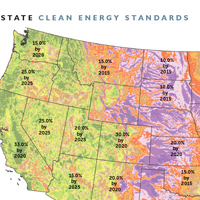While the feds have yet to enact a national renewable energy mandate, 29 states have already taken matters into their own hands. But with rising energy prices is now really the right time to mandate renewable energy?
 Robert Bryce of the Manhattan Institute’s Center for Energy Policy and the Environment doesn’t think so. In his report, “The High Cost of Renewable Electricity Mandates” Bryce says the widespread implementation of RPS mandates couldn’t come at a worse time for the U.S. economy. Instead, he recommends that state electricity regulators perform a thorough financial assessment of the impact that renewable-energy mandates have on electricity prices. Where necessary, he recommends suspending or eliminating renewable-energy mandates.
Robert Bryce of the Manhattan Institute’s Center for Energy Policy and the Environment doesn’t think so. In his report, “The High Cost of Renewable Electricity Mandates” Bryce says the widespread implementation of RPS mandates couldn’t come at a worse time for the U.S. economy. Instead, he recommends that state electricity regulators perform a thorough financial assessment of the impact that renewable-energy mandates have on electricity prices. Where necessary, he recommends suspending or eliminating renewable-energy mandates.
But renewable energy has actually helped lower electricity rates in many areas, such as in many California school districts. And green energy may actually be cheaper than fossil fuels, depending on how you look at it.
But I want to know, what do you think? Do Renewable Energy Portfolios help or hinder?
Filed Under: Policy





Here’s what the SRVUSD said in a Q and A session: Financial consultants have analyzed the solar project and determined that it will provide significant cost savings. After 25 years the savings is expected to exceed $23. The District will be paying for the solar panels with rebates and savings on electricity. All I know is that over 90 schools in CA are choosing to do this because it saves them money since the cost of electricity is so high there. Here is more info http://us.sunpowercorp.com/commercial/success-stories/education/?relType=SP_Content_C&relID=1293997963227
I also want to hear a straightforward answer to Michael’s question. It seems to me that all the cost analyses of renewables that make them seem favorable leave out the tax payer subsidies and an appropriate share of costs of maintaining or extending the distribution grid and whatever generation capacity or energy storage that will be required to maintain 24 x 7 availability.
It seems that the real total costs of renewables are not competitive. So this is the reason proponents seek Renewable Portfolio Standards established by legislation. When the costs become truly favorable either by reduction in the costs of renewables or by increases in the costs of non-renewables, Renewable Portfolio Standards will not be of interest.
Using the example of the California school you provided. A back of the envelope assuming an economic cost of capital of 8.5% over a 20-year assumed life causes the levelized cost of the solar panels to be around $430/MWh. Taxpayer arbitrage takes the capital rate for the school district down to around 2%, lowering the levelized cost to around $250/MWh. Add in an average PTC rate of $23/MWh for the first 10 years, and you get the levelized cost closer to $235/MWh. How does this exactly make financial sense when they still want to be connected to the electricity grid (which itself has an added cost)?